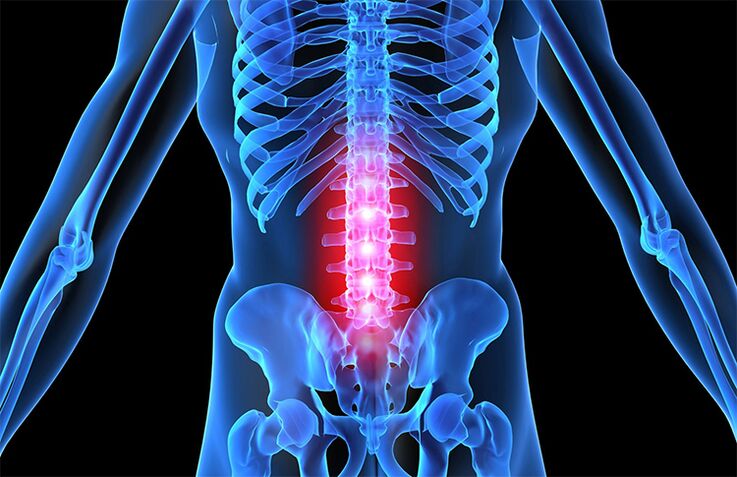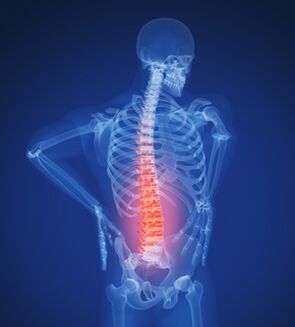
Many people felt pain in the lumbar region at least once after thirty years. By the age of sixty, 80% of people will have these symptoms. The cause is almost always lumbar osteochondrosis. This pathology provokes the development of unpleasant symptoms and can greatly reduce the quality of life of a person. In order to prevent the development of negative consequences, it is extremely important to consult a doctor in a timely manner.
Clinical features of osteochondrosis of the lumbar spine
This disease is widespread, since the lower back most often suffers from high loads. The lumbar region contains five vertebrae, it also connects the sacrum to the thoracic region. The intervertebral discs, consisting of the nucleus pulposus, give it flexibility. These elements are localized within the fibrous ring.
Osteochondrosis provokes a lack of nutrients in the intervertebral discs. This makes them less elastic. In addition, their height is reduced. Reducing the distance between the vertebrae provokes damage to the nerve roots. As a result, noticeable pain in the lumbar region appears.
At the initial stage, the symptoms of osteochondrosis are mild and can even be completely absent. However, further progression of the disease leads to pain in the back and legs, and numbness may develop.
After the spread of changes, the possibility of fixation of the spine decreases. Sometimes hernias and subluxations appear - these disorders are associated with pain. This can even lead to a herniated disc and pinching of the nerve endings.
With the subsequent development of the disease, vessels, ligaments and the spinal cord begin to participate in the process. Bony growths may develop. In the last stage, paralysis and paresis develop. Sometimes the function of the pelvic organs is disturbed.
In young people, the disease progresses continuously. In old age, despite the presence of changes, the pathology may not manifest itself in any way. If treatment of the disease is not started on time, very dangerous consequences can develop.
Degree
The pathology is irreversible, and its symptoms are directly determined by the degree:
- First Degree. During this period, pathological processes appear in the nucleus pulposus. There are ailments associated with irritation of the nerve endings. They can be sharp or painful. When there are spasms of the large arteries of the thigh, blood circulation is disrupted, which is fraught with the appearance of pathologies of the leg arteries.
- second degree. The destruction of the fibrous ring is progressing. Due to the loss of stability, the vertebrae become too mobile. This overstrains the muscle tissue. The patient has high fatigue of the muscles of the lower back, discomfort.
- third degree. The fibrous ring ruptures, resulting in the release of the contents of the nucleus pulposus. This process provokes the formation of a hernia. There are radicular syndromes. Initially, the patient experiences high sensitivity in the affected area, a burning sensation, tingling, numbness. Sometimes the sensitivity can disappear completely. In severe cases, paralysis and muscle wasting develop.
- Fourth degree. The work of the vertebrae, the structure of the joints and ligaments is disturbed. Arthritis develops. The pain can go away, the support function of the spine is restored, but the amplitude in it is significantly reduced. The fourth degree is characterized by a variety of symptoms of the disease.
The reasons

More than a third of patients with such osteochondrosis have problems with the liver or digestive organs. With such deviations, there are tensions and spasms of muscles and blood vessels, provoking a lack of oxygen and the appearance of dystrophic abnormalities. These processes are aggravated by metabolic disorders.
The occurrence of this form of osteochondrosis is often the result of congestion in the pelvic organs. They can be associated with constipation, colitis, hemorrhoids. In women, such problems are the result of inflammation of the appendages, and in men - prostatitis.
Also among the causes of osteochondrosis are:
- lack of physical activity.
- diseases of the joints.
- digestive problems.
- back injury.
- Pathology of the heart and blood vessels.
- Diseases of the endocrine system.
- problems with the spine.
- Inflammation.
- flat feet.
- Increased physical activity.
- metabolic disorder.
- age changes.
There are also risk factors that greatly increase the likelihood of developing lumbar osteochondrosis:
- overweight;
- heredity;
- irrational diet;
- violation of posture;
- long stay in an uncomfortable position;
- chronic sleep deprivation;
- frequent stress;
- hypothermia.
symptoms and signs
The disease manifests itself in the form of a pain syndrome and can have a different character. Osteochondrosis is characterized by pulling, aching, cutting sensations. Discomfort is felt not only in the leg, but also in the coccyx or lower chest.
The photo shows the pain syndrome in osteochondrosis in the lumbar spine

In addition to pain, there are such violations:
- muscle tension;
- problems in the reproductive system;
- violation of the menstrual cycle in women;
- Constipation;
- change in posture;
- asymmetry of the buttocks;
- loss of sensitivity;
- Fatigue;
- tingling and coldness in the legs;
- loss of activity;
- Insomnia;
- emotional instability.
As a rule, exacerbation of osteochondrosis is the result of careless movement or heavy loads. Also, relapse of the disease often occurs due to hypothermia. Sharp pains are felt not only in the lower back - they often affect the lower limbs. During an exacerbation, a person tries to find a comfortable position to achieve the disappearance of pain.
Symptoms of lumbosacral osteochondrosis
This form of the disorder is also characterized by back pain. They can be felt in the lower back or in the leg near the sciatic nerve. Manifestations of the disease do not appear immediately, but approximately at the second stage of the development of the disease.
First of all, they are felt during careless movements or loads. But over time, the pain is constantly present and has an aching character. Sometimes exacerbations occur as the symptoms get worse. In advanced cases, pain occurs when sneezing, coughing, light exertion.
When the nerve endings are pinched, a radicular syndrome develops, which is characterized by such manifestations:
- shootings in the back;
- loss of feeling in the limbs;
- tingling in the legs;
- weakening of tendon reflexes;
- violation of sweating;
- chills of the legs;
- muscle weakness.
As the disease progresses, the back loses flexibility and any change in posture or strain causes severe pain. As a result, mobility is reduced, a person has difficulty bending, muscle spasms.
effects
If you ignore the symptoms of osteochondrosis, sooner or later the disease will lead to negative consequences. As the distance between the vertebrae decreases, the vessels become pinched, which leads to problems with the nutrition of the spinal cord.
As a result, pain, muscle weakness and loss of reflexes occur. Enuresis, fecal incontinence, paralysis of the lower extremities may develop.
Another dangerous complication is a hernia. It also provokes severe pain and compression of the spinal cord. As a result, the legs can lose sensitivity, reflexes disappear. Sometimes the work of the organs of the reproductive and urinary systems is disturbed. Digestive problems can also occur.
This form of osteochondrosis can cause instability of the spine. Under the influence of gravity, the lower back seems to slide away from the sacrum. In women, this condition is fraught with problems with internal organs - the ovaries, uterus and appendages. Men can develop impotence as a result of this disorder.
Lumbar osteochondrosis often causes problems with blood flow to the spinal cord. Another consequence is compression myelopathy. In connection with the narrowing of the spinal canal, problems with the spinal cord appear.
However, the most complex condition is the "ponytail" syndrome, which is considered to be the result of an injury to the nerve roots. In advanced situations, paralysis and paresis of the limbs can occur.
diagnostic methods
To diagnose osteochondrosis, the doctor examines the patient's medical history and conducts a visual examination. Common urine and blood tests are also done. With their help, other serious diseases can be excluded.
An important criterion is the assessment of the condition of the legs. It is important to determine the condition of the skin, blood vessels and muscle tone. Women are referred to a gynecologist in addition to a consultation. Men need to be examined by a urologist.
The following types of diagnostics are required:
- radiography;
- CT scan;
- Magnetic resonance imaging.
How to treat
Medical, physical therapy, and surgical techniques can be used to treat the condition. The main goal is to eliminate the manifestations of the disease and prevent its development.
Of the drugs used are anti-inflammatory and analgesic drugs. Be sure to take vitamin B. To cope with psychogenic disorders, sedatives and anticonvulsants are used. During an exacerbation, a novocaine blockade can be used.
Of the non-drug therapies, remedial gymnastics, acupuncture and massage are the most effective. You can also do electrophoresis and phonophoresis. If conservative methods do not give results, surgery is performed.
Osteochondrosis of the lumbar spine is considered a rather dangerous pathology that can lead to extremely negative health consequences. In order to prevent this, it is very important to see a doctor if you have back problems.




















